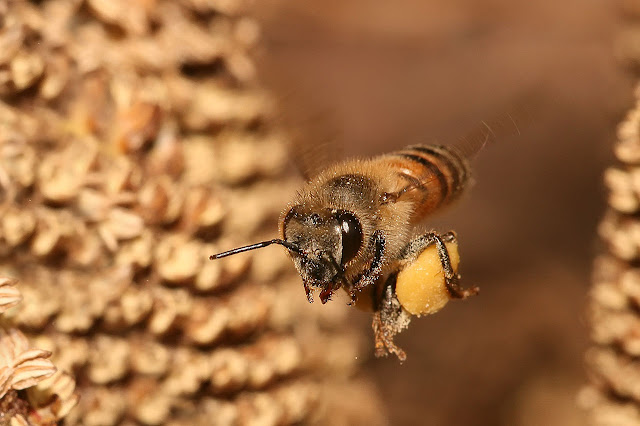Honeybee Facts Part I
Honeybee Facts Part I
Image source:"Apis mellifera flying" by Muhammad Mahdi Karim (www.micro2macro.net) Facebook Youtube - Own work. Licensed under GFDL 1.2 via Commons - https://commons.wikimedia.org/wiki/File:Apis_mellifera_flying.jpg#/media/File:Apis_mellifera_flying.jpg
2. The bee has been known to the human race for many thousands of years. There is a very old educational painting in a rock shelter in Spain depicting bees.
3. Stone Age man ate honey which he stole from the nests of wild bees. Bees were first kept by man in hollow logs with sticks to support the honey combs. Later man kept bees in straw baskets called "skeps" and today, bees are kept in standard hives.
4. There are about 10,000 species of bees which roughly are divided into two main groups: Social Bees that live in colonies and Solitary Bees that live alone.
5. LIQUID HONEY: this honey is extracted from the combs and is sold in glass jars. It is available in many different colours depending on the flowers used by the bee.
6. COMB HONEY: is honey stored by bees in the cells of freshly built comb and is sold as sections or pieces of cut comb in plastic containers.
7. CHUNK HONEY: is liquid honey with one or more pieces of comb honey and is sold in glass jars.
8. CREAMED HONEY: all honeys granulate or crystallise with time. When the rate of crystallisation is controlled, a creamed honey is obtained. Creamed honey is suitable as a spread.
9. Beeswax is a by-product of beekeeping and is a highly valuable product. It has many uses e.g. candle making, polishes, art, cosmetics. It is used in beekeeping as foundation in frames to
encourage bees to build comb.
10. Propolis is a by-product of the hive. It is a sticky substance collected by the worker bees from the buds of various plants and trees e.g. chestnut, laurels, etc. They carry it back to the hive on their hind legs. It is not a food, but a building material. It is used as a type of ‘cement’ to seal any cracks or crevices in the hive.
11. Honey bees must visit some 2 million flowers to make one pound of honey.
12. Honey bees fly about 55,000 miles to bring in enough nectar to make one pound of honey.
13. About one ounce of honey would fuel a honey bee's flight around the world.
14. Honey bees have been producing honey from flowering plants for about 10-20 million years.
15. The average honey bee worker makes 1/12 teaspoon of honey in her lifetime.
16. Honey bees contribute 8 to 10 billion dollars to the U.S. economy yearly.
17. Honey bees have four wings that are latched into pairs by hooks.
18. There are an estimated 200,000 beekeepers in the United States.
19. Honey bees are the only insects that produce food for humans. The male honey bee, the drone, has a grandfather but no father. The average honey bee flies between 12 and 15 miles per hour.
20. A honey bee flaps its wings about 12,000 times per minute.


Comments
Post a Comment